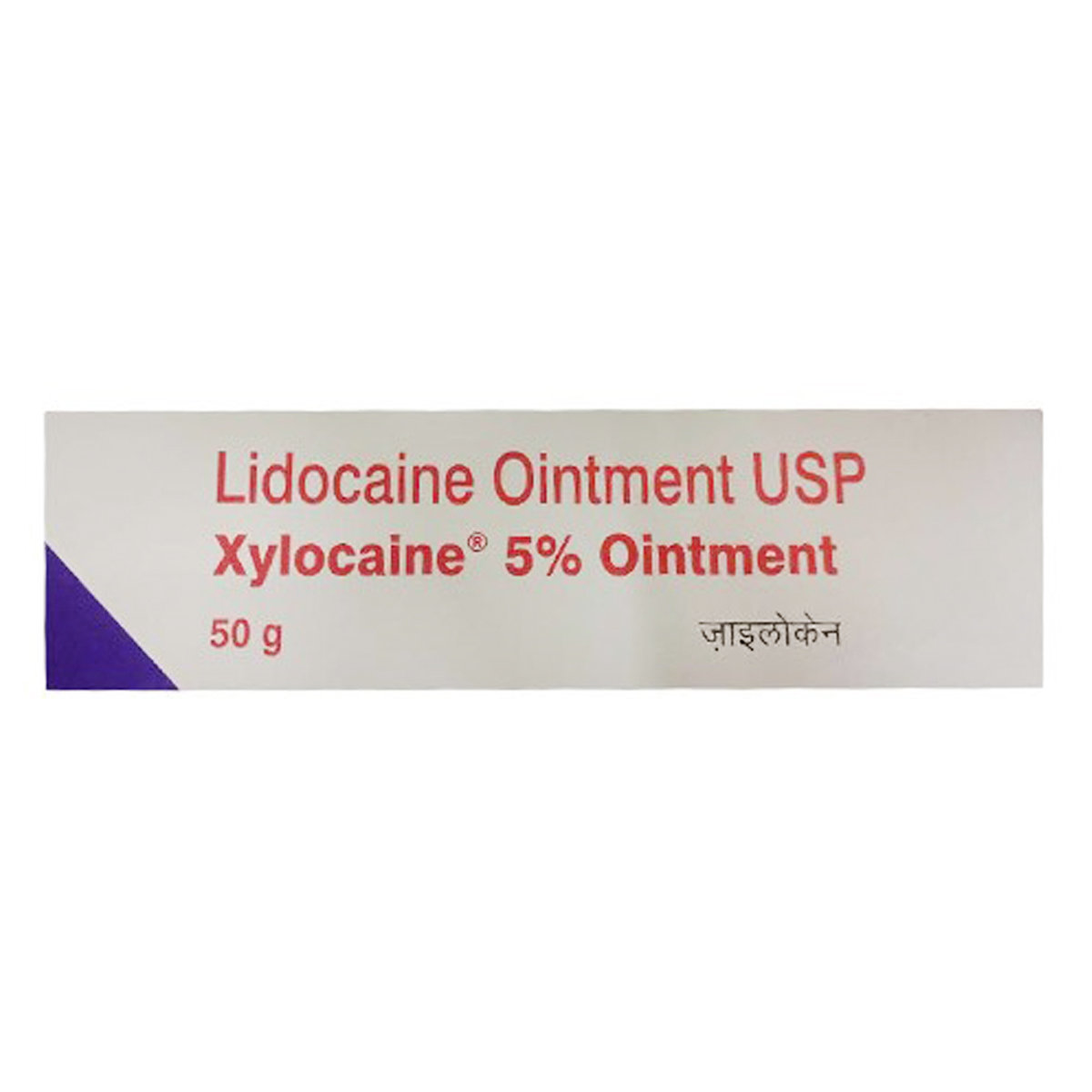Xylocaine 5% Ointment 20 gm


MRP ₹57.5
(Inclusive of all Taxes)
₹8.6 Cashback (15%)
Selected Pack Size:20 gm
20 gm ₹51.8
(₹2.59 per gm)
In Stock
50 gm ₹51.8
(₹1.04 per gm)
In Stock
About Xylocaine 5% Ointment
Xylocaine 5% Ointment belongs to the class of local anaesthetics used to reduce/relieve pain and discomfort associated with skin irritation, burns, scratches, insect bites, skin abrasions, or sunburn. It is also used to treat post-herpetic neuralgia (lasting pain after a shingles infection). Xylocaine 5% Ointment may also be used to treat premature ejaculation. It is also indicated for the prevention and control of pain in urethritis (inflammation of the urethra). Xylocaine 5% Ointment may also be used as an adjunct for endotracheal intubation.
Xylocaine 5% Ointment contains 'lidocaine' that blocks the influx (entry) of sodium ions into the membrane that surrounds the nerves, thereby preventing initiation and conduction of impulses. Xylocaine 5% Ointment produces local numbness by blocking the nerve signal in the affected area. Hence, Xylocaine 5% Ointment produces an anaesthetic effect and helps decrease the sensation of pain.
Use Xylocaine 5% Ointment as advised by the doctor. In some cases, Xylocaine 5% Ointment may cause application site reactions such as burning sensation, itching, redness, and irritation. Most of these side effects do not require medical attention and will resolve gradually over time. However, you are advised to talk to your doctor if you experience these side effects persistently.
Consult your doctor before using Xylocaine 5% Ointment if you are pregnant or breastfeeding. Xylocaine 5% Ointment is not recommended for children as safety and effectiveness have not been established. Avoid contact of Xylocaine 5% Ointment with eyes, nose, or mouth. If contact occurs, rinse with water immediately. Do not apply Xylocaine 5% Ointment on the swollen skin areas or deep puncture wounds. Inform your doctor about your health condition and medications to rule out any side effects/interactions.
Country of origin
Manufacturer/Marketer address
Online payment accepted

secured payment

india's most trusted pharmacy

genuine products
Composition :
Manufacturer/Marketer :
Consume Type :
Expires on or after :
Return Policy :
Available Offers
Provide Delivery Location
About Xylocaine 5% Ointment
Xylocaine 5% Ointment belongs to the class of local anaesthetics used to reduce/relieve pain and discomfort associated with skin irritation, burns, scratches, insect bites, skin abrasions, or sunburn. It is also used to treat post-herpetic neuralgia (lasting pain after a shingles infection). Xylocaine 5% Ointment may also be used to treat premature ejaculation. It is also indicated for the prevention and control of pain in urethritis (inflammation of the urethra). Xylocaine 5% Ointment may also be used as an adjunct for endotracheal intubation.
Xylocaine 5% Ointment contains 'lidocaine' that blocks the influx (entry) of sodium ions into the membrane that surrounds the nerves, thereby preventing initiation and conduction of impulses. Xylocaine 5% Ointment produces local numbness by blocking the nerve signal in the affected area. Hence, Xylocaine 5% Ointment produces an anaesthetic effect and helps decrease the sensation of pain.
Use Xylocaine 5% Ointment as advised by the doctor. In some cases, Xylocaine 5% Ointment may cause application site reactions such as burning sensation, itching, redness, and irritation. Most of these side effects do not require medical attention and will resolve gradually over time. However, you are advised to talk to your doctor if you experience these side effects persistently.
Consult your doctor before using Xylocaine 5% Ointment if you are pregnant or breastfeeding. Xylocaine 5% Ointment is not recommended for children as safety and effectiveness have not been established. Avoid contact of Xylocaine 5% Ointment with eyes, nose, or mouth. If contact occurs, rinse with water immediately. Do not apply Xylocaine 5% Ointment on the swollen skin areas or deep puncture wounds. Inform your doctor about your health condition and medications to rule out any side effects/interactions.
Uses of Xylocaine 5% Ointment
Key Benefits
Xylocaine 5% Ointment belongs to the class of local anaesthetics used to reduce/relieve pain and discomfort associated with skin irritation, burns, scratches, insect bites, skin abrasions, or sunburn. It is also used to treat post-herpetic neuralgia (pain due to shingles-a viral infection). Xylocaine 5% Ointment is also indicated for the prevention and control of pain in urethritis (inflammation of the urethra). Xylocaine 5% Ointment may also be used as an adjunct for endotracheal intubation (a medical procedure involving the placement of a tube into the windpipe through the nose or mouth). Xylocaine 5% Ointment contains 'lidocaine' that blocks the influx (entry) of sodium ions into the membrane that surrounds the nerves, thereby preventing initiation and conduction of impulses. Xylocaine 5% Ointment produces local numbness by blocking the nerve signal in the affected area. Hence, Xylocaine 5% Ointment produces an anaesthetic effect and helps decrease the sensation of pain. Xylocaine 5% Ointment may also be used to treat premature ejaculation. It works by reducing the sensitivity of skin tissue and sensation when applied to the penis. Thereby prevents premature ejaculation.
Directions for Use
Storage
Side Effects of Xylocaine 5% Ointment
- Burning sensation
- Itching
- Redness
- Irritation
Drug Warnings
Do not use Xylocaine 5% Ointment if you are allergic to any of its components. Avoid using Xylocaine 5% Ointment on larger skin areas or for a prolonged duration. Inform your doctor if you have methemoglobinemia (abnormal methemoglobin in the blood), heart, kidney or liver problems. Consult your doctor before using Xylocaine 5% Ointment if you are pregnant or breastfeeding. Xylocaine 5% Ointment is not recommended for children as safety and effectiveness have not been established.
Drug Interactions
Drug-Drug Interactions: Xylocaine 5% Ointment may have interaction with other local anaesthetic drugs and anti-arrhythmic drugs (tocainide, mexiletine).
Drug-Food Interactions: No interactions found/established.
Drug-Disease Interactions: Inform your doctor if you have methemoglobinemia (abnormal methemoglobin in the blood) or heart problems such as irregular heartbeat or heart block.
Drug-Drug Interactions Checker List
- TOCAINIDE
- MEXILETINE
Habit Forming
Diet & Lifestyle Advise
- Maintain a healthy weight by performing regular low-strain exercises and eating healthy food.
- Get adequate sleep as resting the muscles can help in reducing inflammation and swelling.
- De-stress yourself by meditating, reading books, taking a warm bubble bath, or listening to soothing music.
- Eat food rich in antioxidants such as berries, spinach, kidney beans, dark chocolate, etc.
- Foods containing flavonoids help in reducing inflammation. These include soy, berries, broccoli, grapes, and green tea.
- Avoid smoking and alcohol consumption.
Special Advise
- Do not apply Xylocaine 5% Ointment on open wounds, injured skin, or unhealed shingles blisters.
- Wash your hands after use. However, do not wash your hands if you are using Xylocaine 5% Ointment on your hands.
- If Xylocaine 5% Ointment comes in contact with eyes, mouth or nose, wash with water immediately. Consult a doctor if irritation persists.
- Do not scratch or rub the skin when it is numb.
Disease/Condition Glossary
Pain: Pain is a symptom triggered by the nervous system, causing uncomfortable sensations in the body. Pain can be generalized (overall body aches) or localized (affecting a specific area of the body). The common causes of pain include headache, muscle strain, cramps, and cuts.
Local anaesthesia: It causes numbing/loss of sensation to a specific area of the body. It is used to treat pain, or to prevent pain during surgery or medical procedure.
Post-herpetic neuralgia: Post-herpetic neuralgia is a lasting pain in the area of shingles. Shingles is a viral infection that causes painful rashes occurring due to the reactivation of chicken pox virus infection. Symptoms include nerve pain and itchiness.
Premature ejaculation: Premature ejaculation is when a man ejaculates (orgasms) more quickly with less sexual stimulation before the man or his partner would like. This could lead to problems in a sexual relationship. Premature ejaculation is also known as rapid ejaculation, premature climax or early ejaculation. Symptoms include the inability to delay the orgasm or ejaculation for more than a minute after the start of intercourse.
FAQs
Xylocaine 5% Ointment blocks the influx of sodium ions into the membrane that surrounds the nerves, thereby preventing initiation and conduction of impulses (nerve signal). Hence, it provides an anaesthetic effect and decreases the sensation of pain.
Avoid concomitant use of Xylocaine 5% Ointment with other topical products such as cosmetics, sunscreens, lotions, moisturizers, insect repellent creams, and other gels.
Do not apply external heat or cover the treated skin with dressings after applying Xylocaine 5% Ointment. Covering the skin or applying heat might increase the amount of drug absorbed into the skin leading to unpleasant side effects.
Do not apply Xylocaine 5% Ointment on open wounds, injured skin, or unhealed shingles blisters. Apply Xylocaine 5% Ointment on intact skin only.
Avoid using Xylocaine 5% Ointment for longer durations unless prescribed by the doctor. If your condition does not improve even after using Xylocaine 5% Ointment for 7 days, consult your doctor.
Disclaimer
Product Substitutes
Alcohol
Safe if prescribed
It is unknown if alcohol affects Xylocaine 5% Ointment. Please consult your doctor if you have any concerns.
Pregnancy
Consult your doctor
Please consult your doctor if you have any concerns regarding this; your doctor will prescribe Xylocaine 5% Ointment only if the benefits outweigh the risks.
Breast Feeding
Consult your doctor
Please consult your doctor if you have any concerns regarding this; your doctor will decide whether breastfeeding mothers can use Xylocaine 5% Ointment or not.
Driving
Safe if prescribed
It is not known if Xylocaine 5% Ointment affects your ability to drive. Drive only if you are alert after using Xylocaine 5% Ointment.
Liver
Consult your doctor
Xylocaine 5% Ointment should be used with caution in patients with liver impairment/liver disease. Please consult your doctor if you have a liver impairment or any concerns regarding this.
Kidney
Consult your doctor
Please consult your doctor if you have kidney impairment or any concerns regarding this.
Children
Safe if prescribed
Xylocaine 5% Ointment is not recommended for children as efficacy and safety have not been established.
Author Details
We provide you with authentic, trustworthy and relevant information
Reference
- https://www.drugs.com/mtm/lidocaine-topical.html
- https://www.accessdata.fda.gov/drugsatfda_docs/label/2015/020612s012lbl.pdf
- https://www.accessdata.fda.gov/drugsatfda_docs/anda/2011/040837Orig1s000.pdf
- https://www.webmd.com/drugs/2/drug-171248/burn-spray-lidocaine-topical/details
- https://medlineplus.gov/druginfo/meds/a603026.html
- https://www.nps.org.au/medicine-finder/versatis-transdermal-patches
- https://www.drugs.com/cdi/lidocaine-patch.html
Uses of Xylocaine 5% Ointment
Key Benefits
Xylocaine 5% Ointment belongs to the class of local anaesthetics used to reduce/relieve pain and discomfort associated with skin irritation, burns, scratches, insect bites, skin abrasions, or sunburn. It is also used to treat post-herpetic neuralgia (pain due to shingles-a viral infection). Xylocaine 5% Ointment is also indicated for the prevention and control of pain in urethritis (inflammation of the urethra). Xylocaine 5% Ointment may also be used as an adjunct for endotracheal intubation (a medical procedure involving the placement of a tube into the windpipe through the nose or mouth). Xylocaine 5% Ointment contains 'lidocaine' that blocks the influx (entry) of sodium ions into the membrane that surrounds the nerves, thereby preventing initiation and conduction of impulses. Xylocaine 5% Ointment produces local numbness by blocking the nerve signal in the affected area. Hence, Xylocaine 5% Ointment produces an anaesthetic effect and helps decrease the sensation of pain. Xylocaine 5% Ointment may also be used to treat premature ejaculation. It works by reducing the sensitivity of skin tissue and sensation when applied to the penis. Thereby prevents premature ejaculation.
- Consult your doctor if you experience skin redness, itching, or irritation after taking medication.
- Your doctor may adjust your treatment plan by changing your medication or providing guidance on managing your erythema symptoms.
- Your doctor may recommend or prescribe certain medications to help alleviate symptoms.
- Apply cool compresses or calamine lotion to the affected skin area to reduce redness and itching.
- Stay hydrated by drinking plenty of water to help alleviate symptoms and keep your skin hydrated.
- Monitor your skin condition closely and promptly report any changes, worsening symptoms, or concerns to your healthcare provider.
- Report the itching to your doctor immediately; they may need to change your medication or dosage.
- Use a cool, damp cloth on the itchy area to help soothe and calm the skin, reducing itching and inflammation.
- Keep your skin hydrated and healthy with gentle, fragrance-free moisturizers.
- Try not to scratch, as this can worsen the itching and irritate your skin.
- If your doctor prescribes, you can take oral medications or apply topical creams or ointments to help relieve itching.
- Track your itching symptoms and follow your doctor's guidance to adjust your treatment plan if needed. If the itching persists, consult your doctor for further advice.
- Consult and seek guidance from a doctor or healthcare expert to determine the cause and best course of treatment.
- Avoid harsh products, extreme temperatures, and other potential irritants that may exacerbate the issue.
- Depending on the location and severity of the burning, your healthcare professional may recommend applying a soothing or protective agent, such as a cream, gel, or ointment.
- Keep the affected area clean to promote healing and prevent further irritation.
- Schedule follow-up appointments with your healthcare professional to monitor your symptoms and adjust your treatment plan as needed.
- If the burning or irritation persists or worsens, seek medical attention for further guidance and treatment.
Directions for Use
Storage
Drug Warnings
Do not use Xylocaine 5% Ointment if you are allergic to any of its components. Avoid using Xylocaine 5% Ointment on larger skin areas or for a prolonged duration. Inform your doctor if you have methemoglobinemia (abnormal methemoglobin in the blood), heart, kidney or liver problems. Consult your doctor before using Xylocaine 5% Ointment if you are pregnant or breastfeeding. Xylocaine 5% Ointment is not recommended for children as safety and effectiveness have not been established.
Therapeutic Class
Drug-Drug Interactions
Drug-Drug Interactions
Login/Sign Up
Drug-Drug Interactions Checker List
- TOCAINIDE
- MEXILETINE
Diet & Lifestyle Advise
- Maintain a healthy weight by performing regular low-strain exercises and eating healthy food.
- Get adequate sleep as resting the muscles can help in reducing inflammation and swelling.
- De-stress yourself by meditating, reading books, taking a warm bubble bath, or listening to soothing music.
- Eat food rich in antioxidants such as berries, spinach, kidney beans, dark chocolate, etc.
- Foods containing flavonoids help in reducing inflammation. These include soy, berries, broccoli, grapes, and green tea.
- Avoid smoking and alcohol consumption.
Habit Forming
Side Effects of Xylocaine 5% Ointment
- Burning sensation
- Itching
- Redness
- Irritation
Special Advise
- Do not apply Xylocaine 5% Ointment on open wounds, injured skin, or unhealed shingles blisters.
- Wash your hands after use. However, do not wash your hands if you are using Xylocaine 5% Ointment on your hands.
- If Xylocaine 5% Ointment comes in contact with eyes, mouth or nose, wash with water immediately. Consult a doctor if irritation persists.
- Do not scratch or rub the skin when it is numb.
Disease/Condition Glossary
Pain: Pain is a symptom triggered by the nervous system, causing uncomfortable sensations in the body. Pain can be generalized (overall body aches) or localized (affecting a specific area of the body). The common causes of pain include headache, muscle strain, cramps, and cuts.
Local anaesthesia: It causes numbing/loss of sensation to a specific area of the body. It is used to treat pain, or to prevent pain during surgery or medical procedure.
Post-herpetic neuralgia: Post-herpetic neuralgia is a lasting pain in the area of shingles. Shingles is a viral infection that causes painful rashes occurring due to the reactivation of chicken pox virus infection. Symptoms include nerve pain and itchiness.
Premature ejaculation: Premature ejaculation is when a man ejaculates (orgasms) more quickly with less sexual stimulation before the man or his partner would like. This could lead to problems in a sexual relationship. Premature ejaculation is also known as rapid ejaculation, premature climax or early ejaculation. Symptoms include the inability to delay the orgasm or ejaculation for more than a minute after the start of intercourse.
All Substitutes & Brand Comparisons
RX
Xylocaine 5% Ointment 50 gm
Zydus Cadila
₹57.5
(₹1.04/ 1gm)
59% CHEAPERRX
Out of StockLox 5% Ointment 20gm
Ultra Drugs Pvt Ltd
₹23.5
(₹1.06/ 1gm)
59% CHEAPER

Have a query?
Buy best Anaesthetics products by
Neon Laboratories Ltd
Themis Pharmaceutical Ltd
Troikaa Pharmaceuticals Ltd
Samarth Life Sciences Pvt Ltd
Abbott India Ltd
Astra Zeneca Pharma India Ltd
Baxter India Pvt Ltd
Core Claris Lifesciences Ltd
Celon Laboratories Pvt Ltd
Ajanta Pharma Ltd
Miracalus Pharma Pvt Ltd
Torrent Pharmaceuticals Ltd
Zydus Cadila
AP Pharmaceutical
Fresenius Kabi India Pvt Ltd
Galpha Laboratories Ltd
Indoco Remedies Ltd
Anglo French Drugs & Industries Ltd
B Braun Melsungen AG
Cadila Pharmaceuticals Ltd
Claris Lifesciences Ltd
Dr Reddy's Laboratories Ltd
Elder Pharmaceuticals Ltd
Fortel Life Sciences
Hetero Healthcare Pvt Ltd
Icpa Health Products Ltd
Pure Derma Healthcare Pvt Ltd
Salve Pharmaceuticals Pvt Ltd
Sunways (India) Pvt Ltd
VARENYAM HEALTHCARE PVT LTD
Wockhardt Ltd
Zydus Healthcare Ltd
6Ipain Healthcare Pvt Ltd
Admac Lifesciences(Oncology)
Aesmira Lifesciences Pvt Ltd
Albatross Healthcare Pvt Ltd
Amwill Healthcare Pvt Ltd
Anchal Life Science Pvt Ltd
Atopic laboratories Pvt Ltd
Biovenice Criticure
Cellgen Biopharma
Cipla Ltd
Delvin Formulations (P) Ltd
Entod Pharmaceuticals Ltd
Ethinext Pharma
Foremost Marketing Pvt Ltd
Fusion Health Care Pvt Ltd
German Remedies Ltd
Global Dent Aids Pvt Ltd
Greycells Lifesciences Pvt Ltd
Himeros Pharmaceuticals Pvt Ltd
Ici India Ltd
Icpa Lab
Ikon Remedies Pvt Ltd
Intas Pharmaceuticals Ltd
Kopran Laboratories Ltd
Kshipra Health Solutions
Leeford Healthcare Ltd
MSP Pharmaceuticals
Medimarck Biotech
Modi Mundipharma Pvt Ltd
Mylan Pharmaceuticals Pvt Ltd
Optima Healthcare Solutions
Pericles Pharma
Pharmadent Remedies Pvt Ltd
Piramal Enterprises Ltd
Pristine Pearl Pharma Pvt Ltd
Questus Pharma Pvt Ltd
Ranbaxy Laboratories Ltd
Rusan Healthcare Pvt Ltd
Scott Edil Pharmacia Ltd
Skinocean Pharmaceuticals
Themis Chemicals Ltd
Themis Medicare Ltd
Ultra Drugs Pvt Ltd
Vhb Life Sciences Inc
Zee Laboratories Pvt Ltd










_0.jpg?tr=q-85)



